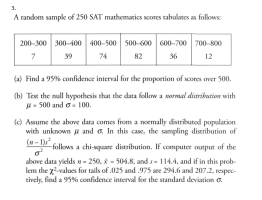
I understand how to do Part A. For Part B, am I supposed to use a chi-square test for goodness-of-fit based on expected counts where 400-500 and 500-600 are each supposed to be 34% of 250 (85) and etc. to compare this to the normal distribution? Then the outer columns as 0.11*250 and 0.05*250, respectively? If I do this, I get a P value of 0 which means rejection of the null. Just would like to know if I'm doing this right.
And for Part C, I set up (249)(114.4)^2 / sd^2 = 207.2 and (249)(114.4)^2 / sd^2 = 294.6 to get an interval of 105.22 to 125.43.
Thanks
Audentes
